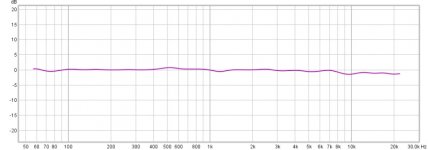About the foam lens.
You'd probably benefit from doing a vertical slit/cat eye pupil instead of a hole.
It lets through far more highs to play with in EQ and you don't need much if any dispersion vertically (and if you did, that could be easily helped by just angling the speaker).
Cut out two nice beefy bars of open cell foam with a right-angle triangular cross-section, and use that as the lens.
You'd probably benefit from doing a vertical slit/cat eye pupil instead of a hole.
It lets through far more highs to play with in EQ and you don't need much if any dispersion vertically (and if you did, that could be easily helped by just angling the speaker).
Cut out two nice beefy bars of open cell foam with a right-angle triangular cross-section, and use that as the lens.
Last edited:
About the foam lens.
You'd probably benefit from doing a vertical slit/cat eye pupil instead of a hole.
It lets through far more highs to play with in EQ and you don't need much if any dispersion vertically (and if you did, that could be easily helped by just angling the speaker).
Cut out two nice beefy bars of open cell foam with a right-angle triangular cross-section, and use that as the lens.
Absolutely yes, I've not tried it yet as wanting as wide a dispersion at all axis for stage monitor use, but yes it is very flexible re modifying dispersion for different applications. It was the rising response in particular that caught my attention re this driver as has some spare to play with but ultimately want to minimise losses.
I'm quite keen to have a go with a short waveguide and foam combo to make a horizontal mid/hi F.O.H array, for this I would try the slit approach as would want an asymmetrical dispersion pattern.
I will try and get some more measurements done with different 'lenses' soon.
Sorry to interrupt the thread, but this is a message to user "elb"...
I cannot reply to your PMs if you have chosen not to receive them.
You need to enable receipt of PMs your user control panel or I can't help you.
Steve.
Hi Steve,
I have just checked my settings and the PMs is enabled to receive!
@elb
How about I just post the cab dimensions here. There's nothing special about them, it's only a sealed cab after all. Material is 18mm softwood ply, nice and cheap and remarkably good for speaker cabs, i've found.
Top/bottom - 17" x 13 3/8"
Sides - 12" X 26"
Front/back - 17" x 26"
There is a "holey brace" 14 1/4" on centre from the top of the front back board, connecting all four walls.
That's it.
How about I just post the cab dimensions here. There's nothing special about them, it's only a sealed cab after all. Material is 18mm softwood ply, nice and cheap and remarkably good for speaker cabs, i've found.
Top/bottom - 17" x 13 3/8"
Sides - 12" X 26"
Front/back - 17" x 26"
There is a "holey brace" 14 1/4" on centre from the top of the front back board, connecting all four walls.
That's it.
@elb
How about I just post the cab dimensions here. There's nothing special about them, it's only a sealed cab after all. Material is 18mm softwood ply, nice and cheap and remarkably good for speaker cabs, i've found.
Top/bottom - 17" x 13 3/8"
Sides - 12" X 26"
Front/back - 17" x 26"
There is a "holey brace" 14 1/4" on centre from the top of the front back board, connecting all four walls.
That's it.
Thank you Steve.
SubSoniks:
So the measurements where with 2x30mm thickness uniform OCF pieces, the inner with 120mm opening centered, and using a common type speaker grill?
Sorry I could have been clearer, all foam is 6mm thick 8 layers in total, all other measurements are hole sizes, currently using pieces of perforated aluminium sheet for grills.
Below is the normalised response with just the two grills:
Attachments
that is nice. Here's a slot lens patent with something like a phase plug
US20120121118A1 - Slotted waveguide for loudspeakers
- Google Patents
US20120121118A1 - Slotted waveguide for loudspeakers
- Google Patents
Sorry I could have been clearer, all foam is 6mm thick 8 layers in total, all other measurements are hole sizes, currently using pieces of perforated aluminium sheet for grills.
Below is the normalised response with just the two grills:
.... Two grills?
So: Grill - 6mm Foam x 8 - Grill
?
How much smoothing is applied?
I can be a bit dense, please use a teaspoon or dot counter.
so there's very little attenuation on-axis. How close does your lens group the horizontal polars vs no lens? I've seen a vertical ellipse on a 15" narrow tings down in the 2K region (IIRC) then lost effect higher. I have one of those Fane 12" but when MCM transitioned to Newark, Newark dropped Fane and several other manufacturers.
Yes, an inner grill to hold the foam away from the cone and the outer one to clamp the foam down, so grill - foam - grill.
A side effect of using the foam is a reduction of Qms, reducing Qts from approx 0.68 to around 0.52, of course this is dependant on hole sizes , thickness of foam and I guess also the rigidity of the grills as Fs also reduces to around 50Hz down from 57Hz.
A side effect of using the foam is a reduction of Qms, reducing Qts from approx 0.68 to around 0.52, of course this is dependant on hole sizes , thickness of foam and I guess also the rigidity of the grills as Fs also reduces to around 50Hz down from 57Hz.
Last edited:
- Home
- Loudspeakers
- Full Range
- New 12" Full-Range: Fane 12-250TC
